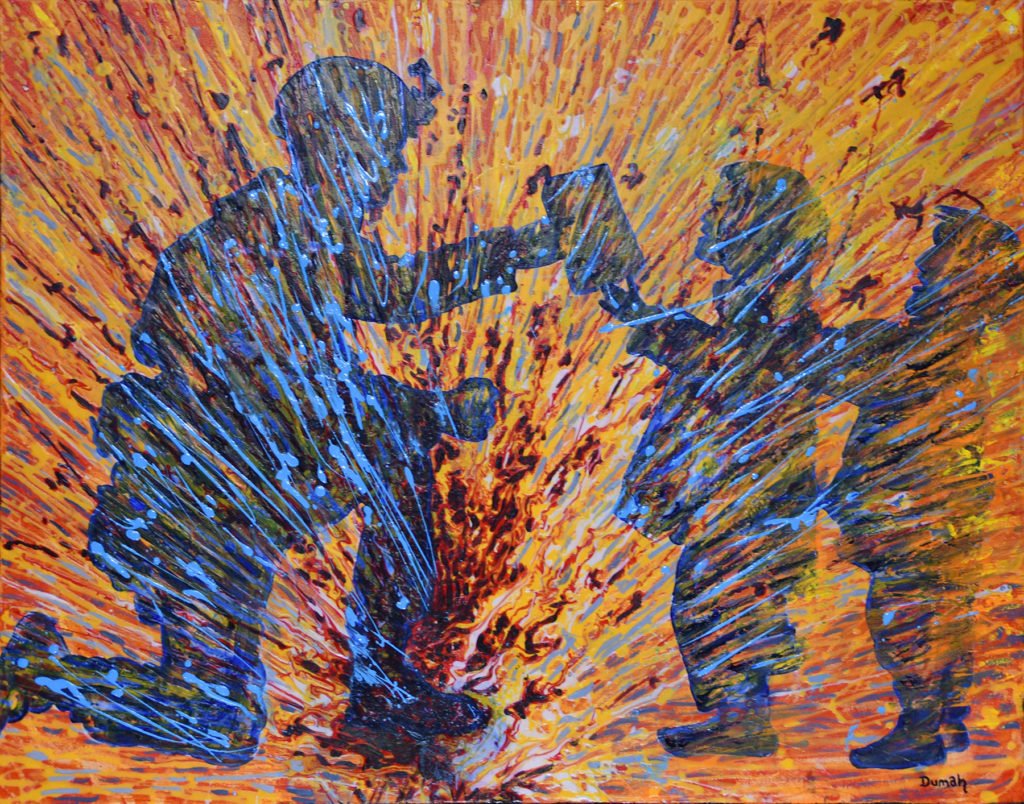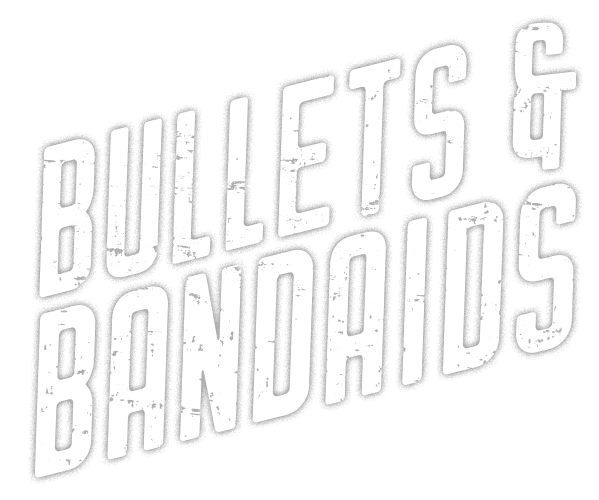
Dumah Morgan
30” x 24” • Acrylic on Canvas
Original Artwork, created for Bullets and Bandaids Vol. 3 (2021)
Shipping: $100 flate rate, continental US (shipping insurance included)
My art is inspired by positive energy. The world that we live in needs more positivity and I believe that starts with each of us. In my work I choose subjects that are rich in positive healing energy. Using swirls of color and lively brush strokes I capture this energy onto canvas. Nature and live music are two of my favorite sources of this healing energy. Painting nature scenes in Plein Air gives me the special opportunity to connect directly with nature and literally paint what I am feeling and seeing at that moment. Live music is even more energetic. The reciprocal connection between musicians and their fans is like no other art form. My live paintings record this live experience in a way that you can see the music and feel the good vibes. My mission as an artist is to create pieces of art that people can connect with and instantly feel a positive vibe.
When I read the Veteran’s interview for the first time, one thing that stood out to me was the story of soldiers passing out school supplies to children in bombed out school buildings. That contrast of relentless bombings and eager school kids was very interesting to me. At first I could not even read the remainder of the interview. I just kept getting visions of this painting and the contrast both visually and metaphorically. To me it could just as well be a contrast of peace & war, love &. hate, or good & evil.
Inspired by the experiences of Andrew Cooke
Hearts and Minds
by Jes Sdao
What does it mean for someone to be considered a hero? By most measures, Andrew Cooke is a hero for sure. Heroism in spades. Valor coming out the ears. A decorated veteran, serving in three wars over the span of his military career, an honorable retirement due to health issues directly related to physical trauma suffered in combat. A leader, a trainer, promoted time and time again, serving in support of special operations, intelligence, security forces, someone who consistently put his life on the line to protect our freedoms, day in and day out, for the better part of his adult life.
But Andrew doesn’t tell his story in those terms. Heroism isn’t even in his vocabulary. Instead, you hear him speak of his friends, his fellow airmen, the men from Romania, Belgium, and England serving alongside his unit in Kandahar, Afghanistan. You hear him wisecracking about the differences between marines and army and air force as they all sat through countless hours of specialized training at a Navy school, surrounded by a culture that created separatism, bred pride in identity, and ultimately trained men and women to not only fight and win, but above all to protect their fellow soldiers.
To hear Andrew speak of the regular rocket attacks, you notice a slightly upward glance. Perhaps he’s envisioning those rockets, glaring red in the cold night, a sound he grew used to, sleeping through most of the fireworks once he realized that the most fearsome concern was less the explosions and more the combat fatigue. Finding fellow airmen slumped over in tiny shacks, knowing that at any point in time, the boogeyman most pressing was no longer a foreign enemy, but your own thoughts, swirling louder in your skull, drowning out the explosions, forgetting the sound of your loved one’s voice, hearing only that you may not make it out alive, and maybe it’s best to go out on your own terms.
And still these men stick together, grieving, praying, hoping, and showing up to do their jobs. Protecting one another, fighting against the faceless enemy. Training, running, preparing, always ready for anything to happen. Walking out into a country none had ever seen before, standing out in a culture only experienced in training. The enemy is no longer so faceless when you hear a child asking you for books, for notebooks, for pencils, fulfilling the outreach humanitarian mission that provides not food, not candies, not the expected creature comforts, but the most basic school supplies, passed out to young girls, finally given back the opportunity to get an education. The enemy is not these children, it is not their mothers. The enemy is not the citizens who smile at you, who interpret the language for your unit, who share food and tea with weary soldiers. The enemy becomes more real when you see their ominous presence painted across every aspect of a nation.
Andrew was woken by a sound more jarring than the typical rockets one early morning in May at Bagram Airfield. In the largest attack at an air base since the Vietnam War, soldiers went straight to the task of protecting and defending. Andrew’s primary responsibility was managing the large fleet of vehicles; with no other information about the attack making its way out due to a downed communications system, the well-oiled military machine was operating on sheer instinct. Soldiers donned protective gear, readied weapons, made their way to their posts. Encountering friends and fellow soldiers along the way, what little information they could find trickled out in code as every person jumped straight to the jobs they had trained to do. The faceless enemy then had a face, and every face was pounding at the door, climbing the fence, rushing the gate, demanding to be let in, demanding control of this key air base, willing to take what they believed they had a right to by force of death—their own, or the lives of the American soldiers sworn to protect it—whose life was immaterial to the terrorist forces infiltrating Bagram Air Base before dawn on May 19th. At his office, Andrew handed another airman his spare jacket so that the two of them could ready the vehicle fleet for other soldiers, a vital element to successfully fighting against the attackers. As the attack on the base faded, the operations to push the enemy out began. Andrew was on a fire team inside an MRAP (mine-resistant ambush protected vehicle) as a weapons technician when a nearby explosion disabled the vehicle; the explosion caused a large piece of machinery to shift, briefly pinning Andrew inside the vehicle before he was able to push it off his chest and evacuate the vehicle, with only minor injuries. After a full day of fighting, security forces neutralized the threat, at least long enough for the men to rest, to eat, to begin picking up the literal and figurative pieces, and go back to doing their jobs. The events of May 19th were not simply a job well done, as many of the soldiers began to experience signs of PTSD after that day. Andrew began jogging, partly to relieve stress and tension, clearing his head as the desert sand settled under his running shoes.
Returning to his home base at Davis-Monthan in Tucson, AZ, Andrew began mandatory therapy appointments, and continued to run for both physical and mental health. At the end of a 5K race, he collapsed 200 feet from the finish line—medics rushed to his aid, discovering dangerously low blood pressure and a barely detectable pulse. In a state of shock, Andrew was admitted to the hospital, where he remained for nearly a week, undergoing countless tests, all indicating a perfectly healthy body, and no clear explanation as to why his heart consistently stopped for 4-6 second intervals repeatedly, why he lost consciousness regularly, and why his blood pressure plummeted randomly. Andrew left the hospital and met with a cardiology team, who advised a pacemaker at the young age of 28. He declined the procedure initially, in the hopes of finding the root cause of the issue, and was sent to an electrophysiologist. After some black box experimentation, she found a medication that worked enough to be able to drive again and take steps towards leaving the house safely. It was now time to re-focus on getting his mind stable. A new therapist suggested Andrew slowly participate in more social activities, getting used to crowds and expand his photography hobby as a means of therapeutic release. He began to hone his craft by photographing weather and landscapes from long distances using a telephoto lens. Photographing nature from distances was cathartic, as he found himself transported and focused entirely in the moment. Long exposure photos to capture phenomena like lightening bolts enabled him to process negative thought patterns and find a productive way to rejoin the world around him. Hours spent behind the camera, were transformative, changing a coping skill into a passion, which then led to a thriving photography business in Tucson. With his heart condition under control, and regular therapy sustaining his mental wellness, Andrew moved back to South Carolina to be closer to family. The stress of moving across the country took its toll, but he was once again able to find stability with new cardiologists, new therapists, and a new environment to photograph.
After a few years passed, Andrew embarked on a new journey. Not simply a photography studio reminiscent of the one he owned in Tucson, but a full-service media company. His passion for photography, grown out of the need to sort out internal trauma, blossomed into a successful business with a large network of friends supporting one another through outreach, art, and encouragement.
